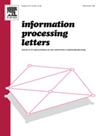线段的离散和混合双中心问题
IF 0.6
4区 计算机科学
Q4 COMPUTER SCIENCE, INFORMATION SYSTEMS
引用次数: 0
摘要
给定一组n个不相交线段L和R2中的一组m个点Q;我们给出了(i)O(m(m+n)log2中(i)覆盖,(ii)刺入和(iii)击中集合L的离散双中心问题的算法n) ,(ii)O(m2nlogn) 和(iii)O(m(m+n)log2n) 其中两个圆盘以Q的两个点为中心并且较大圆盘的半径被最小化。我们还研究了(i)覆盖,(ii)刺和(iii)击打集合L的混合双中心问题,其中只有一个圆盘以点qi∈Q为中心,另一个圆盘在R2中的任何点为中心,这三个问题在(i)O(mnlogn) ,(ii)O(mn3logn) 和(iii)O(mnlog2n) 时间。所有这些算法的空间复杂性都是线性的。本文章由计算机程序翻译,如有差异,请以英文原文为准。
Discrete and mixed two-center problems for line segments
Given a set of n non-intersecting line segments and a set Q of m points in ; we present algorithms of the discrete two-center problem for (i) covering, (ii) stabbing and (iii) hitting the set in (i) , (ii) and (iii) time respectively, where the two disks are centered at two points of Q and radius of the larger disk is minimized. We also study the mixed two-center problems for (i) covering, (ii) stabbing and (iii) hitting the set , where only one of the disks is centered at a point and the other disk is centered at any point in , and these three problems are solved in (i) , (ii) and (iii) time, respectively. The space complexities for all these algorithms are linear.
求助全文
通过发布文献求助,成功后即可免费获取论文全文。
去求助
来源期刊

Information Processing Letters
工程技术-计算机:信息系统
CiteScore
1.80
自引率
0.00%
发文量
70
审稿时长
7.3 months
期刊介绍:
Information Processing Letters invites submission of original research articles that focus on fundamental aspects of information processing and computing. This naturally includes work in the broadly understood field of theoretical computer science; although papers in all areas of scientific inquiry will be given consideration, provided that they describe research contributions credibly motivated by applications to computing and involve rigorous methodology. High quality experimental papers that address topics of sufficiently broad interest may also be considered.
Since its inception in 1971, Information Processing Letters has served as a forum for timely dissemination of short, concise and focused research contributions. Continuing with this tradition, and to expedite the reviewing process, manuscripts are generally limited in length to nine pages when they appear in print.
 求助内容:
求助内容: 应助结果提醒方式:
应助结果提醒方式:


